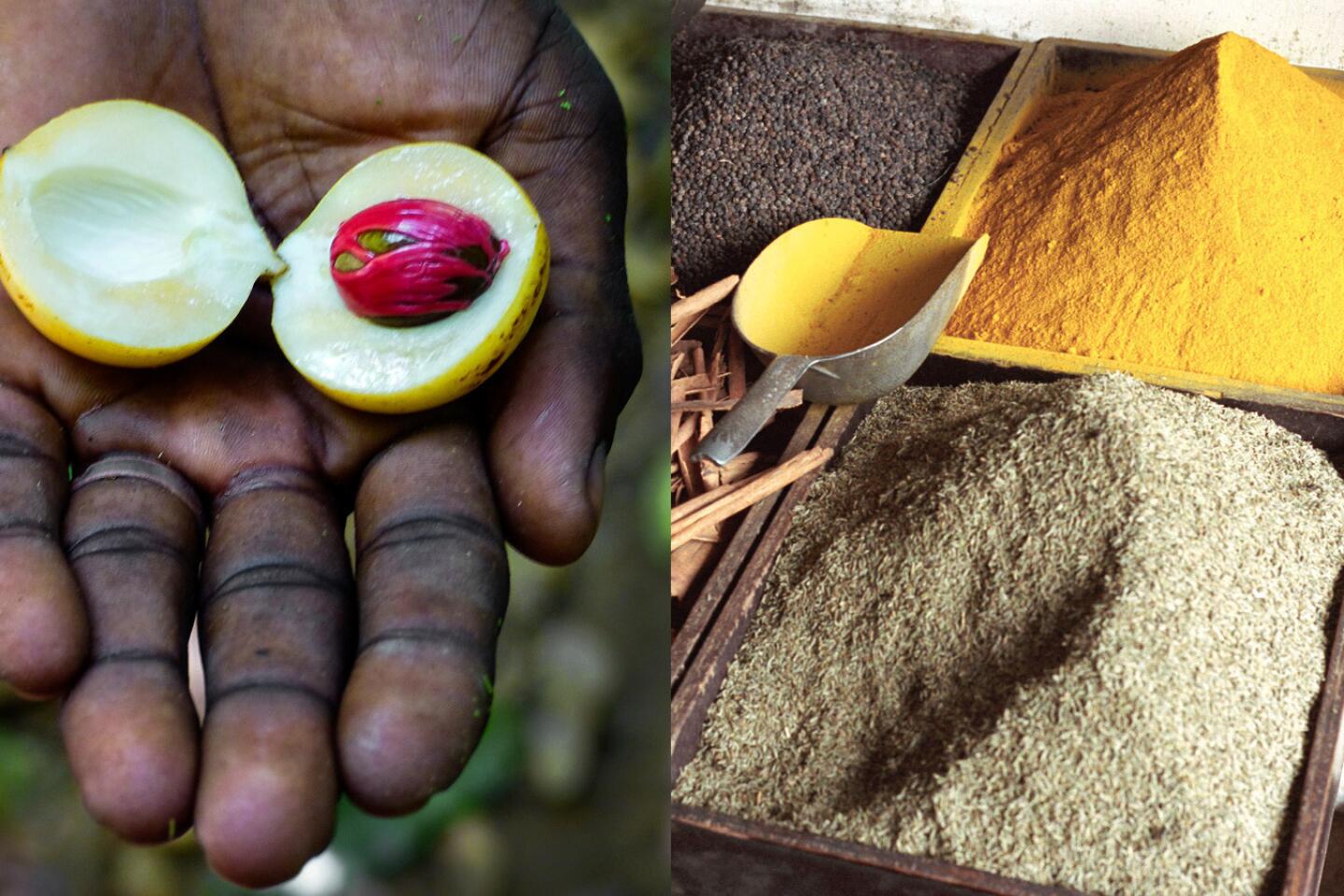The gift to travelers visiting Zanzibar, the Spice Island, is right under their noses
- Share via
Reporting from Zanzibar — “Here. What do you think this is?” Genes Salema, our guide for the day, crushed a handful of green leaves in his hands and held them out to us.
We leaned down and inhaled. The scent was bracing, piquant, familiar. Pumpkin pie? Spiced cider? But what spice? We started guessing. Cinnamon? Nutmeg?
Salema smiled with each wrong answer.
“Clove,” he said, and pointed to an adjacent grove. “These trees are more than 70 years old, and they give us two harvests a year.”
He clipped off a small branch and showed us a clump of flower buds at the tip, which, when dried, will be exported to kitchens far and wide.
It turned out we weren’t just smelling cloves, but the scent of history and the scent of Zanzibar, also known as the world’s foremost Spice Island.
It was in early March and my wife, Jody Jaffe, and I were on a tour at the Kizimbani Spice Farm, a government-run research area on Unguja, the largest island in the small Zanzibar archipelago that’s been part of Tanzania since 1964.
During our leisurely three-hour amble through groves and lush fields, we encountered a spice drawer of tropical condiments, including clove, nutmeg, pepper, ginger, lemon grass, cinnamon, turmeric, cardamom and vanilla.
Between rounds of the “what does this smell like?” game, Salema discussed Zanzibar’s spice-trade history and gave us a taste of local lore.
Each spice, it seemed, had a story to tell.

On nutmeg: “If you drink a soda or fruit drink with grated nutmeg,” he told us, “then you have sexy eyes. Like Viagra for women.”
On the power of cloves: “The toothache remedy,” he said. “That’s a painkiller to allow you to go to sleep, then in the morning you go to the doctor.
“Also, this is the spice if the meat is too gamey — it makes it gameless.”
On fast-growing pepper vines: “They say if you stand up this way, the vine will grow on you,” he said, legs apart, arms outstretched.
MORE AFRICA: In Zambia, a safari means going with the flow »
On the home use of lemon grass: “If you put dried lemon grass on the fire, it gets rid of all mosquitoes and it smells like lemon.”
Salema also gave us a quick lesson on local agriculture. “Cassava,” he said pointing to a field of knee-high plants at a small private farm. “It is very important during fasting time, lots of calories.”
“Fasting time” in Zanzibar means Ramadan, the holy month of Islam, a time when believers don’t eat during daylight hours. Mainland Tanzania is predominantly Christian; Zanzibar is overwhelmingly Muslim.
Occupied by Arab merchants for centuries and then by the Portuguese, Zanzibar was at first a stop on a complex trading route from East Africa to the Mideast and beyond.
Many of its spices were introduced to the archipelago from India, Indonesia and Malaysia.
But in 1840 Sultan Seyyid Said moved his capital from Oman to Zanzibar and, with the help of an army of slaves, established vast clove plantations and made the island the clove capital of the world.
The Spice Island was born.
Although Zanzibar no longer dominates the clove trade, it still does a brisk business in spices and spice tourism. A walk down Shangani Street or Kenyatta Road in Stone Town, the historic labyrinthine heart of Zanzibar City, will take you past more than a dozen tourist agencies offering spice tours.
During our morning in Kizimbani we encountered at least five other tour groups, several with eight to 10 people. We went with Indian Ocean Magic Tours, a Zanzibar-based company established in 2003.
Spice tours can last from two hours to most of a day. We saw prices as low as $12 per person — depending on whether it was a group or private tour, or whether lunch was included — and some tours are twice that. Some tack on stops at a local beach or an excursion to Prison Island just off Zanzibar’s east coast.
We began our spice day with a 30-minute morning drive from Zanzibar City into a countryside of small farms and roadside shops. As we neared Kizimbani, the route became lined with open-air, thatched-roofed spice shops.
Our tour mixed botany — for instance, we learned that the bright red covering of the nutmeg kernel becomes mace when dried and ground — with a bit of Borscht Belt.
The next-to-last stop was at a coconut palm grove where, along with a group of Ukranian tourists, we drank milk from freshly slice coconuts and watched a harvester climb one of the 50-foot trees while singing the Kenyan pop song “Jambo Bwana” and joking with the audience below.
One of the spices we encountered on the farm was yellow ginger, better known as turmeric. It’s Jody’s biggest spice crush; she uses it for everything: cooking, drinking and medicating.
“The most useful plant in the galaxy,” she said.
Salema sliced into a turmeric root, revealed its bright ocher interior, and Jody rubbed it on a swollen bug bite.
The next morning at breakfast in our Stone Town hotel, I noticed that Jody’s fingers were still stained turmeric yellow after more than 20 hours and two showers.
The stain finally faded a day later, but we’ve retained more tangible memories.
Our final stop was at one of those thatched-roof spice shops. You can’t come to Spice Island without buying spices. And, yes, the Zanzibar curry chicken we had the other night at home was not only delicious but also a fast trip back to Africa’s spice capital.
travel@latimes.com
@latimestravel
More to Read
Sign up for The Wild
We’ll help you find the best places to hike, bike and run, as well as the perfect silent spots for meditation and yoga.
You may occasionally receive promotional content from the Los Angeles Times.













